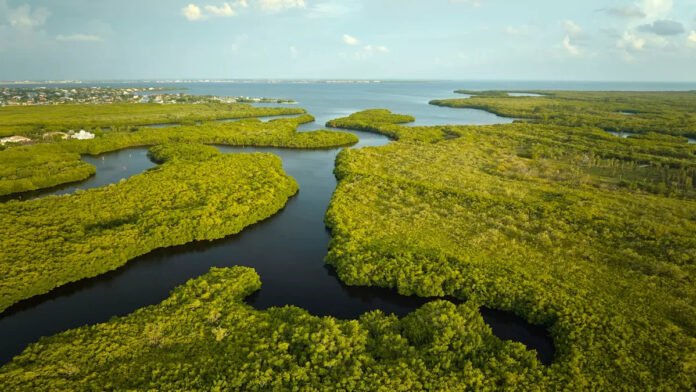Ecosystems have been discovered to exhibit a range of unique responses to rising sea levels.
What’s happening?
A study conducted by Yale School of Environment scientists examined the impact of rising sea levels on various ecosystems.
The research, published in the Journal of Environmental Management, broke down the surprising ways that more submerged and saline soils can influence our planet’s processes.
Although some crops thrive in saltwater-infused land, many ecosystems cannot survive without freshwater.
Working alongside the Florida Coastal Everglades Long-Term Ecological Research program, the researchers studied three ecosystems: a mixed zone of freshwater and saltwater called an ecotone, a grassy area known as a marl prairie, and an area of wetland filled with scrub mangroves, which are trees that can exist in salt-laden environments.
All three ecosystems are vital in the Everglades for removing carbon dioxide from the environment and storing it in the soil, a process known as carbon sequestration. Although the scrub mangroves sequestered the same amount of carbon dioxide, the other two ecosystems showed a decrease in efficiency.
Watch now: Giant snails invading New York City?
However, the predictions that rising sea levels could damage the Everglades beyond repair may not be 100% accurate if conservationists work to adapt to the changing environment.
Sparkle Malone, co-author of the study, said, “When we examine how these ecosystems are responding to the changing conditions, then predictions look very different.”
Why is carbon sequestration so important?
Natural carbon sequestration by crops, grassland, soil, and oceans has a profound, positive impact on the planet. If rising sea levels reduce the efficacy of carbon sinks such as the Everglades, harmful carbon dioxide levels will only become more of an issue.
The Clarity and Leadership for Environmental Awareness and Research Center found that “about 25 percent of our carbon emissions have historically been captured by Earth’s forests, farms and grasslands.”
The Everglades have been under environmental threat due to carbon pollution, but the area can provide an immense way to fight rising carbon dioxide levels.
Per Florida Atlantic University, Everglades mangrove trees are estimated to “hold enough carbon to heat more than 19 million homes, while the water conservation areas in the central Everglades store the equivalent carbon emitted by 131.5 million passenger vehicles over an entire year.”
What’s being done about carbon sequestration?
With rising sea levels making ecosystems more marshy and saturated with saltwater, Everglades conservationists must alter the way they view carbon sequestration.
Although the Yale School of Environment study highlights the importance of restoring freshwater, there is a recognition that this ecosystem must be supported to adapt to the changing climate.
Malone described it as a “significant change in mindset.” This could look like expanding coastal ecosystems and planting more mangroves so that the Everglades remain an effective source of removing carbon from the atmosphere.
Another broader solution is to protect the planet against rising sea levels. Burning dirty energy sources such as coal and gas creates the planet-overheating pollution that warms the Earth and causes sea levels to rise. A transition to cleaner energy could help slow the heating of the planet, which would in turn reduce the impact of rising sea levels on carbon sinks such as the Everglades.
Join our free newsletter for weekly updates on the latest innovations improving our lives and shaping our future, and don’t miss this cool list of easy ways to help yourself while helping the planet.
